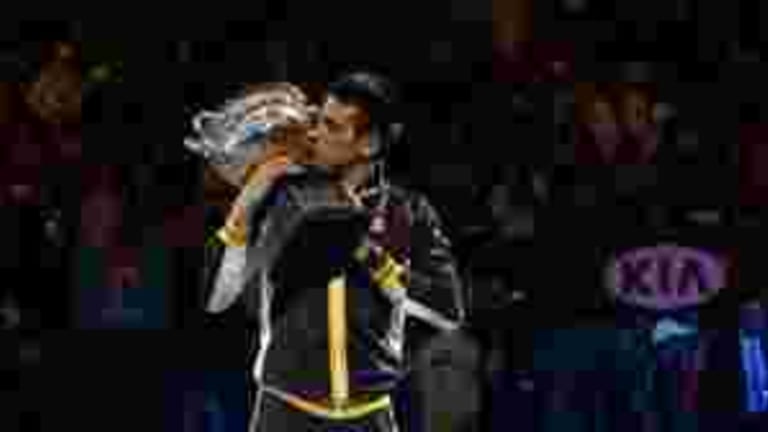MELBOURNE—Novak Djokovic has been called a tennis contortionist for his ability to twist his body and reach seemingly unreachable shots. The metaphor can be extended to the way he wins many of his Grand Slam matches: Nole bends—sometimes to the point where you’re not sure he’ll be able to straighten back up again—but he very rarely breaks.
The best example of Djokovic’s roundabout path to success at this year’s Australian Open was, of course, his fourth-round, five-set win over Stan Wawrinka (in retrospect, the high point of the two weeks). That night he fell behind a set and 2-5 before rallying. In the final tonight against Andy Murray, Djokovic, agitated at having squandered five break point chances during the first set, played a slack and unhappy tiebreaker to lose it. A few minutes later, he was unhappier still as he went down 0-40 on his serve. Djokovic was tense and out of sorts, slipping on the court, glaring at his player’s box, berating himself on changeovers, and struggling with his some of his favorite shots, including his patented defensive backhand.
In other words, Nole had his old friend Andy right where he wanted him.
As he did against Wawrinka, Djokovic righted himself in time to avoid going down two sets to love. Which was a good idea: No player in the Open era has come back from two sets down to win the Australian Open (it’s never been done at Wimbledon or the U.S. Open, either).
As often happens when you carry a No. 1 player’s aura with you on court, Novak got a little help with his comeback. Up 15-40 on Djokovic's serve at 1-0 in the second set, Murray had a look at a mid-court backhand that he could have smacked. He had smacked similar shots for winners in his last match, against Roger Federer. Instead, Murray, thinking that Djokovic was out of sorts and ripe for a mistake, pushed it back and hoped for an error. Djokovic chose that moment to stop being out of sorts. He saved three break points and held with a confident forehand attack. In those five minutes, the match had changed. Djokovic was on his feet again.
“There were a few turning points in the match,” Djokovic said. “Maybe one of them was the second game in the second set when I was 0-40 against the breeze. He missed a few shots and I managed to have that crucial hold. After that I just felt mentally a little bit lighter and more confident on the court than I’d done in the first hour or so."
A somber but not devastated Murray agreed. “At this level, it can come down to just a few points here or there,” he said. He even managed to twist his mouth into a smile or two during his press conference—talk about a contortionist. “My biggest chance was at the beginning of the second set; didn’t quite get that. When Novak had his chance in the third, he got his.”
Murray boiled it down succinctly. He didn’t take his chance in the second set; Djokovic did take his, when Murray served at 3-4 in the third. To that point, the two players had been cruising on serve. The game’s best returners somehow combined to hold their first 31 service games (Murray speculated that the surface, which was quicker here this year, helped in that regard.) In the 32nd game, though, they woke everyone up by staging a 36-shot rally, which Djokovic ended with a forehand winner. Fired up, he hit another forehand winner for 0-40 and broke two points later.

